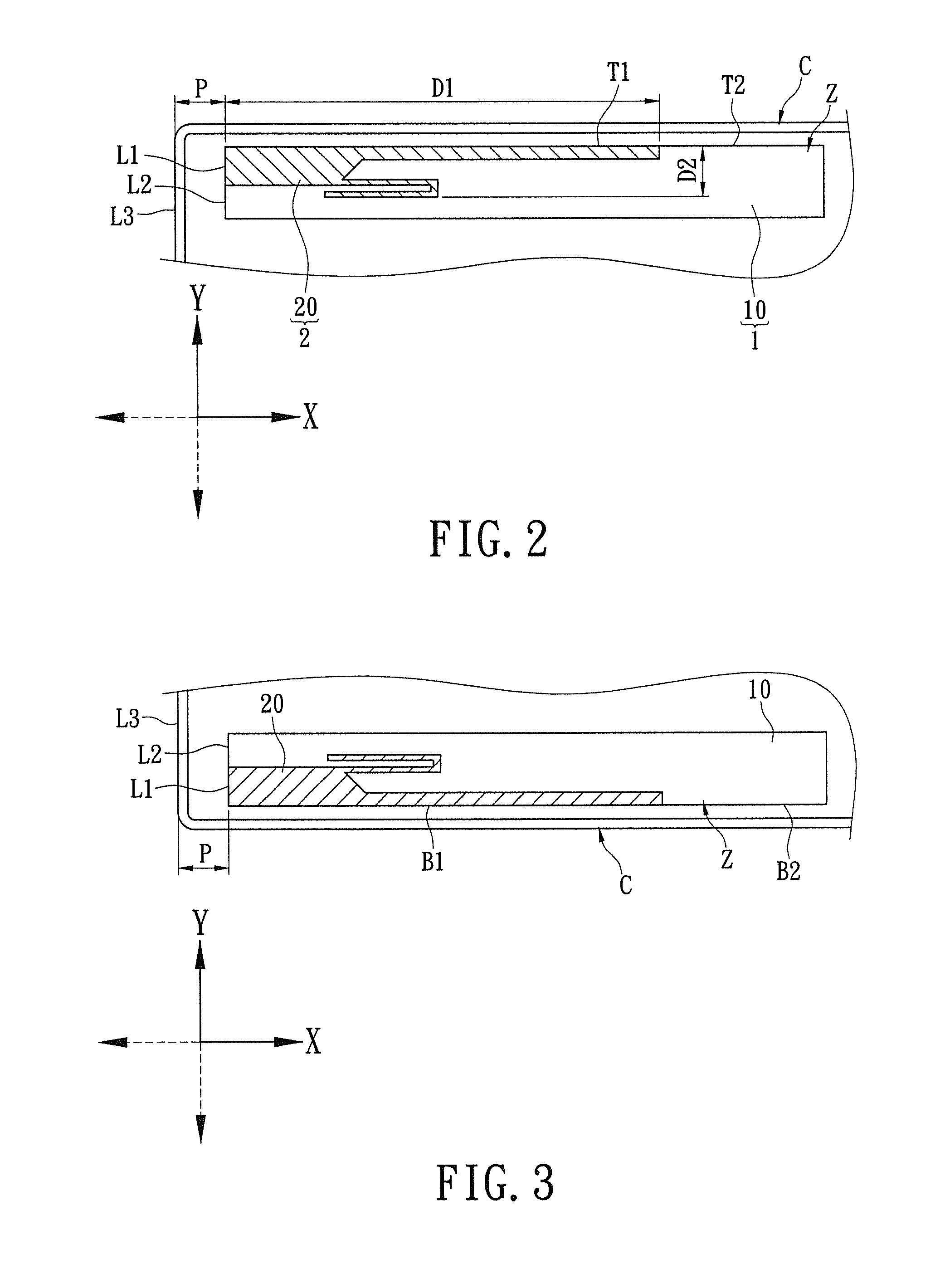Antenna structure for reducing the SAR value
a technology of antenna structure and sar value, which is applied in the direction of antenna coupling, antenna details, antennas, etc., can solve the problems of reducing the sar value effectively to less than 1.6 mw/g, and the cost of manufacturing the whole system is great, so as to reduce the sar value
- Summary
- Abstract
- Description
- Claims
- Application Information
AI Technical Summary
Benefits of technology
Problems solved by technology
Method used
Image
Examples
first embodiment
[0021]Referring to FIGS. 1 and 2, where the first embodiment of the instance disclosure provides an antenna structure Z disposed inside an external casing C (such as the casing of any electronic device) according to an optimum separation distance P for reducing the SAR value, and the antenna structure Z comprises a substrate unit 1 and an antenna unit 2. For example, the external casing C has a plurality of corner areas (A1, A2, A3 and A4 shown as the four phantom-line areas in FIG. 1) disposed in the external casing C and adjacent to the external surface of the external casing C, and the antenna structure Z can be disposed on one of the corner areas (A1, A2, A3 and A4) of the external casing C. For example, the antenna structure Z is disposed on the corner area A1 of the external casing C.
[0022]Referring to FIG. 2, the substrate unit 1 includes at least one substrate body 10. For example, the substrate body 10 may be a microwave substrate. However, the microwave substrate is merely...
second embodiment
[0025]Referring to FIGS. 1 and 3, where the second embodiment of the instance disclosure provides an antenna structure Z using an optimum separation distance P for reducing the SAR value. Comparing FIG. 3 with FIG. 2, the difference between the second embodiment and the first embodiment is that: the antenna structure Z of the second embodiment can be disposed on one corner area A2 of the external casing C. Moreover, the leftmost side L1 of the antenna layer 20 along the X-axis direction can be substantially flushed with the leftmost side L2 of the substrate body 10 along the X-axis direction, and the bottommost side B1 of the antenna layer 20 along the Y-axis direction can be substantially flushed with the bottommost side B2 of the substrate body 10 along the Y-axis direction. Of course, the optimum separation distance P also can be defined from the leftmost side L1 of the antenna layer 20 along the X-axis direction to the leftmost side L3 of the external casing C along the X-axis d...
third embodiment
[0026]Referring to FIGS. 1 and 4, where the third embodiment of the instance disclosure provides an antenna structure Z using an optimum separation distance P for reducing the SAR value. Comparing FIG. 4 with FIG. 2, the difference between the third embodiment and the first embodiment is that: the antenna structure Z of the second embodiment can be disposed on one corner area A3 of the external casing C. The optimum separation distance P can be defined from the rightmost side R1 of the antenna layer 20 along the X-axis direction to the rightmost side R3 of the external casing C along the X-axis direction. Moreover, the rightmost side R1 of the antenna layer 20 along the X-axis direction can be substantially flushed with the rightmost side R2 of the substrate body 10 along the X-axis direction, and the topmost side T1 of the antenna layer 20 along the Y-axis direction can be substantially flushed with the topmost side T2 of the substrate body 10 along the Y-axis direction.
PUM
 Login to View More
Login to View More Abstract
Description
Claims
Application Information
 Login to View More
Login to View More - R&D
- Intellectual Property
- Life Sciences
- Materials
- Tech Scout
- Unparalleled Data Quality
- Higher Quality Content
- 60% Fewer Hallucinations
Browse by: Latest US Patents, China's latest patents, Technical Efficacy Thesaurus, Application Domain, Technology Topic, Popular Technical Reports.
© 2025 PatSnap. All rights reserved.Legal|Privacy policy|Modern Slavery Act Transparency Statement|Sitemap|About US| Contact US: help@patsnap.com



